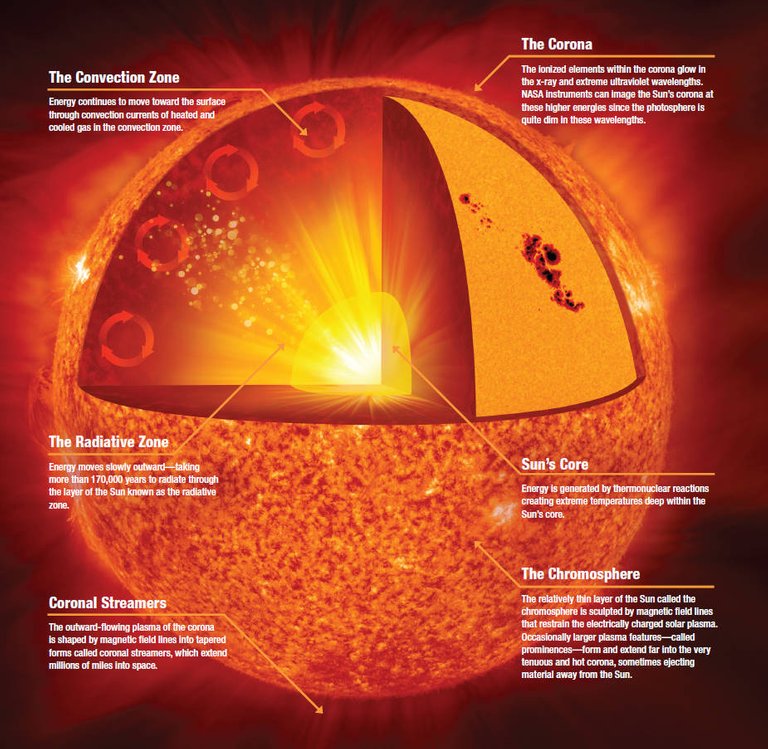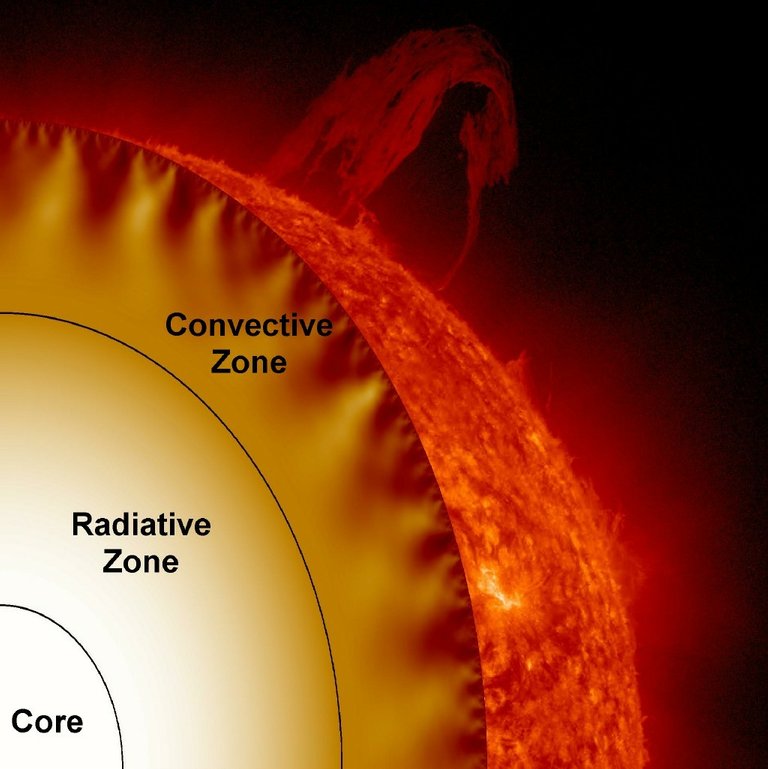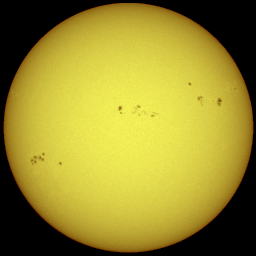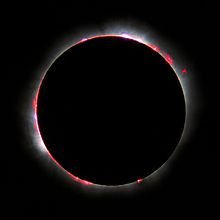So last time we were discussing about the very basic of Sun(its formation, source of endless enegy and composition), if you missed that one then here is the link to go.
Today we also again going to peep into our Sun and will learn the structure of Sun and various layers forming it, so without any wasting of time lets begin.
Structure of Sun
Like our Earth, Sun is also made up of different layers mainly inner region(containing the layers like Core, Radiative zone, Tachocline and convection zone) and atmosphere( it contains layers like photosphere, chromosphere and corona) as shown below:-

Inner region of Sun
As mentioned above, Inner region is further consists of another 4 layers-- Core, Radiative zone, Tachocline and Convective zone( where Tachocline is only a transition between radiative and convective zone).

Inner region is invisible to us and is the part of Sun, where nuclear fusion takes place.Lets know more about each layer of Inner region of Sun.
CORE:-
The core is the centermost layer of Sun which extends up to 20-25% of the solar radius.It has a density about 150 gram per centimeter cube and have a temperature of about 15.7 million kelvin.
Core of the Sun is only the layer where nuclear fusion i.e. proton-proton chain reaction takes place.Why proton-proton chain reaction occurs only in core??The answer is simple the proton-proton nuclear fusion requires a massive large amount of temperature to start the reaction. The high temperature provides a large amount of thermal energy to protons and as a result they start moving quickly causing nuclear reactions.
The proton-proton chain occurs around  times each second in the core, converting about
times each second in the core, converting about .gif) protons into helium nuclei. Fusing four free protons (hydrogen nuclei) into a single helium nucleus releases around 0.7% of the fused mass as Energy.
protons into helium nuclei. Fusing four free protons (hydrogen nuclei) into a single helium nucleus releases around 0.7% of the fused mass as Energy.
Core is able to produce such a large amount of thermal energy because of its large size and high density.So it is clear that core is the main source of thermal energy of Sun.
Radiative zone:-
Radiative zone is next to core, which is spread upto 70% of Sun's radius. The temperature of radiative zone ranges from 1-2 million kelvins, which decreases with increase in distance from the core.
Light and heat produced by nuclear fusion in the core travels through radiative zone in form of radiations. Although radiative zone is not as dense as the core , but it is still so dense that light from the core bounces around taking about 1,70,000 years to move through the radiative zone.
Tachocline:-
Tachocline is the transition layer separating the radiative zone and convective zone.Tachocline layer have a very large shear (stress) because here rotation rate changes very rapidly i.e. rotation changes from uniform rotation of the radiative zone to the differential rotation of the convective zone.
Convective zone:-
This is the outermost layer of the inner region of Sun.It extends from a depth of 2,00,000 km up to the visible surface of Sun.The transportation of energy in this layer takes place by convection.
Convection zone is made of plasma (electrified gas) which consists 70% hydrogen, 27.7% helium with small quantities of carbon, nitrogen and oxygen.The convection zone of Sun is heated by radiations from radiative zone, which makes it convective.
These were the layers forming the inner region of Sun.
Atmosphere of Sun
Atmosphere of Sun is visible to us, which contains three layers-- Photosphere, Chromosphere and Corona. Atmosphere of the Sun is mainly used to spread light from the inner region of Sun to whole solar system.Lets know more about each layer and its function.
Photosphere:-
Photosphere is lowest layer of Sun's atmosphere.It is about 300 miles thick and here Sun's energy is released as light.This is the visible layer of Sun and its temperature is around 5500 degree celsius, which is much cooler than its core.
The temperature of photosphere varies from place to place, giving rise to sun spots, which are mainly cool regions of photosphere ranges from 3000 to 4500 degree celsius as shown below:-

Chromosphere:-
Chromosphere is the layer above to photosphere.Its name has been derived from Greek word chroma which means color, as chromosphere looks bright red during a solar eclipse as shown below:

It is extended upto 2000 km above the visible surface of Sun. The density of plasma in this region isower than photosphere.As it has low density of plasma , it is mainly hidden from our view.But it might be visible in solar eclipse .The temperature of chromosphere increases gradually with altitude up to 20,000 k.
Corona:-
Corona is outermost layer of Sun.Here light from the chromosphere exists as solar wind,which is distributed to whole of the solar system.Corona and chromosphere are separated from each other by a transition region having thickness of about 200km.
The average temperature of corona is about 10,00,000-20,00,000 K. Although no theory can explain fully about corona's temperature because in some region its temperature reaches up to 80,00,000-20,000,000.
So these were the three layers forming the atmosphere of Sun.
References
(https://www.nasa.gov/mission_pages/iris/multimedia/layerzoo.html)
(https://www.google.co.in/amp/s/amp.space.com/58-the-sun-formation-facts-and-characteristics.html)
(https://www.google.co.in/amp/s/amp.space.com/17160-sun-atmosphere.html)
Thanks for reading!

Good post as always
Thanks friend, love to hear this..
Hey there, thank you for writing scientific content, can you please specify if your images are free from copyright? Otherwise I can't curate your post, thanks
Thanks for stopping by, yes the images are copyright free becuase the sites from where i have taken these have not put any restriction and copyright on them.
Congratulations, your post had been chosen by curators of eSteem Encouragement program. Feel free to join and reach us via Discord channel if you have any questions or would like to contribute.
Also,
CREATING YOUR PROFILE IS EASY! JUST FOLLOW THE STEPS HERE ☜(ˆ▿ˆc)
You can trade your earned credstars for SBD!
"This is the outermost layer of the inner region of Sun. It extends from a depth of 2,00,000 km up to the visible surface of Sun." - incredible scale that is difficult to imagine.
Thanks for sharing useful information.
Its my pleasure friend..